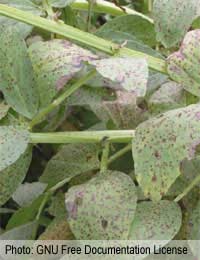Avoiding Botrytis: Fungal Infection

Botrytis is a depressingly common fungus that affects a wide range of plants, particularly in the spring and autumn, since it thrives best in cool, damp conditions that tend to occur at these times of year.
Also known as grey mould after the characteristic fluffy growth that appears on the surface of affected plants, botrytis is one of the most recognisable fungal infections, and one of the most difficult to deal with once it has managed to get a hold.
Early recognition of the signs of infection is the key to preventing too much damage from being done, but clearly the best method of control is avoiding infection in the first place. Of course, no matter how hard you try, you cannot always guarantee success, but there are a few simple precautions you can take which can certainly help to tilt the odds in your favour.
Good Management
Good management is the best weapon against botrytis – and the trick is to avoid providing the conditions which suit it best and allow it to spread. The fungus does well in cool, damp and poorly ventilated environments, so ensuring that the soil is free draining allowing good air movement will be big steps towards reducing the risk for your plants.Over watering and overcrowding also favour the fungus, so water carefully, especially at the times of the year when botrytis is most likely, and space out your plants to cut down on the chance of cross-infection.
Things are a little easier if you are growing plants in a greenhouse, since you aren’t quite so much at the mercy of the weather and the environment is a lot easier to control; try to aim for an atmosphere that is slightly on the dry side.
If, despite all your efforts, you are unfortunate to see signs of botrytis, it’s important to remove damaged plant material thoroughly and burn it to prevent re-infection and any shelves, staging or other hard surfaces will need a regular cleaning with a suitable disinfectant. In the greenhouse, make sure to reduce any chance of condensation as best as you can and maximise the air flow to limit the spread of the fungus.
Spotting the Signs of Infection
Botrytis enters through any damaged parts of the plant, affecting the leaves, stems, flowers and fruits. The first sign of infection is usually the immediate area turning brown and rotten, with grey fluffy mould subsequently forming over the plant surface. This fuzzy growth appears particularly quickly in damp conditions, spreading rapidly over the plant or fruit.A humid environment also favours spore production and large numbers are produced which can spread the infection rapidly – hence the importance of keeping the surroundings well ventilated and slightly dry wherever possible.
Plants affected by this pest do not necessarily have to show all of these symptoms. When conditions are not humid enough to support the growth of the fuzzy mould, the fungus can still cause plants to shrivel and rot, while tomatoes and cyclamen flowers may only show very small pale areas of infection – known as “ghost spots.”
Although some of the commonly available fungicides will give a measure of protection against botrytis, according to the Royal Horticultural Society, there are none available for amateur use which are designed specifically to control this mould. From a practical point of view, the lack of a ready-made chemical solution simply reinforces the importance of good management and preventative measures in dealing with one of the most common and potentially damaging of fungal problems in the garden.
Whichever way you look at it, avoiding botrytis is a much better approach than trying to eradicate it once it’s got itself established.


Re: Do Rabbit Droppings Attract Mice or Rats?
Except for rat droppings, how can I tell if a rat or mouse has been eating my rabbits food? This morning I…
Re: Do Rabbit Droppings Attract Mice or Rats?
Get a cat! They will at least chase (and maybe kill or maim) a mouse or rat!!!
Re: Do Rabbit Droppings Attract Mice or Rats?
I have my two bunnies as backyard bunnies. I got a bit lazy and had left Cheerios (their favorite treat) out on…
Re: Flies: Houseflies and Bluebottles
I my first-floor flat, (whose windows are normally closed because of traffic noise) I have, in last few days, suddenly had…
Re: Do Rabbit Droppings Attract Mice or Rats?
Excuse my ignorance but I need to clarify something. Someone wrote in about finding a rat inside the cage with…
Re: Do Rabbit Droppings Attract Mice or Rats?
I have a pet rabbit and have just had to try and chase a wild mouse out of the room its now down in the walls of…
Re: Flies: Houseflies and Bluebottles
My daughter lives in a ground floor flat an has had a major fly problem all the time she's been there 18 months. These are…
Re: Flies: Houseflies and Bluebottles
Inundated with house flies - small but two days running in my kitchen and sitting room - keeping doors to rest of flat shut.…
Re: Flies: Houseflies and Bluebottles
For the past days flies have been appearing one at a time, up to 30 a day. There is no smell and we cant find any food etc.…
Re: Flies: Houseflies and Bluebottles
@Ry - I know how you feel. It seems to be worse in August. I think it's the fact that our bins are only emptied once a…